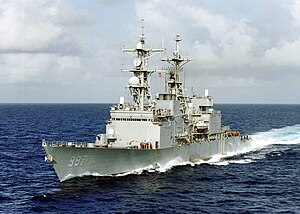| USS Hayler (DD-997) | |
|---|---|
 | |
| Career (US) | |
| Namesake: | Robert W. Hayler |
| Ordered: | 29 September 1979 |
| Builder: | Ingalls Shipbuilding |
| Laid down: | 20 October 1980 |
| Launched: | 2 March 1982 |
| Acquired: | 10 February 1983 |
| Commissioned: | 5 March 1983 |
| Decommissioned: | 25 August 2003 |
| Struck: | 6 April 2004 |
| Fate: | Sunk as a target, 13 November 2004 |
| General characteristics | |
| Class & type: | Spruance class destroyer |
| Displacement: | 8,040 (long) tons full load |
| Length: | 529 ft (161 m) waterline; 563 ft (172 m) overall |
| Beam: | 55 ft (16.8 m) |
| Draft: | 29 ft (8.8 m) |
| Propulsion: | 4 × General Electric LM2500 gas turbines, 2 shafts, 80,000 shp (60 MW) |
| Speed: | 32.5 knots (60 km/h) |
| Range: |
|
| Complement: | 19 officers, 315 enlisted |
| Sensors and processing systems: |
AN/SPS-49 air search radar AN/SPG-60 fire control radar AN/SPS-55 surface search radar AN/SPQ-9 gun fire control radar Mk 23 TAS automatic detection and tracking radar AN/SPS-65 Missile fire control radar AN/SQS-53 bow mounted Active sonar AN/SQR-19 TACTAS towed arrayPassive sonar |
| Electronic warfare & decoys: |
|
| Armament: |
|
| Aircraft carried: | 2 x Sikorsky SH-60 Seahawk LAMPS III helicopters. |
| Motto: | Courageous in Conflict |
| Badge: |
 |
USS Hayler (DD-997), the last Spruance-class destroyer, was the first ship of the United States Navy to be named for Vice Admiral Robert W. Hayler (1891–1980).
History[]
For fiscal year 1978, Congress authorized the production of two additional Spruance-class destroyers, though they funded only one. These were intended to be built as helicopter destroyers (DDH), provided they would not cost more than a standard Spruance-class. Litton-Ingalls completed sketch design work for DDH-997, which moved the helicopter deck aft, stretching the length of the hangar and displacing the Sea Sparrow launcher to the top of the hangar. The design would have accommodated two SH-3 Sea Kings or four smaller SH-60 Seahawk or SH-2 Seasprite helicopters. While the prospective DDH-997 probably wouldn't have cost much more to build than a standard Spruance-class, the detail design and engineering work required before the ship could be built would have been substantial (similar work for the Kidd-class cost $110.8 million). This raised the cost of the DDH substantially above a standard Spruance-class destroyer. While this additional cost might have been justified if the DDH was going to enter series production, it was difficult to justify for a single ship. Accordingly the Navy built Hayler to the same design as the rest of the class.
Hayler was laid down on 20 October 1980 by Ingalls Shipbuilding, in Pascagoula, Miss.; launched on 2 March 1982; and commissioned on 5 March 1983.
Fate[]

The end of USS Hayler, 13 November 2004
Hayler was decommissioned 25 August 2003 at Norfolk Naval Shipyard, Portsmouth, Va. She was stricken from the Naval Vessel Register on 6 April 2004 and sunk as a target on 13 November 2004, during the 2004 Sink Exercise.
Ship's crest[]
Hayler's crest is representative of Vice Admiral Hayler's inspiring leadership, his dedication to his country, his proficiency as a naval officer, and of the history and traditions of the naval service.
The gold stars on the blue background in the upper area of the shield symbolize the many Pacific Island Campaigns Admiral Hayler participated in as a Commanding Officer, and as a Commander of a cruiser division during World War II. The stars also represent the numerous awards he received, some repeated two and three times. The chevron is a symbol of strength and support, and the blue crosses represent the Admirals's three Navy Crosses, an award for valour exceeded only by the Medal of Honor.
The crossed red battle axes are a symbol of strength and resourcefulness under fire, and represent Admiral Hayler's wartime service. The two stars they bear are in recognition of the Silver and Bronze Stars awarded to Admiral Hayler for valour. The bomb represents naval firepower, gunfire support and anti-aircraft fire, and symbolizes the contributions of Admiral Hayler to the development of naval ordnance at the outbreak of World War II.
The anchor refers to the fleet, and Admiral Hayler's efforts toward its strength and safety. The predominant colors, red, white, and blue, are representative of the national flag, and Admiral Hayler's patriotism and loyalty to the flag and the nation it represents.
See also[]
External links[]
| Wikimedia Commons has media related to USS Hayler (DD-997). |
| |||||||||||
The original article can be found at USS Hayler (DD-997) and the edit history here.